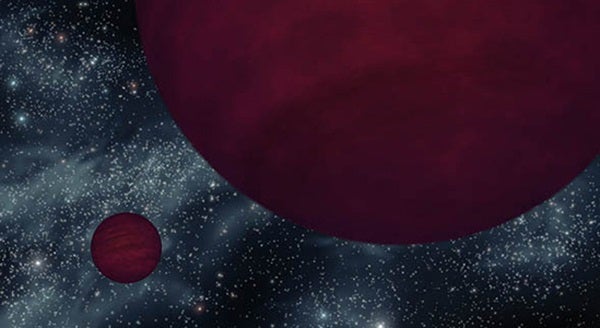An international team, led by astronomers at the University of Hertfordshire in the United Kingdom, has discovered what may be the coolest sub-stellar body ever found outside our own solar system. Using the United Kingdom Infrared Telescope (UKIRT) in Hawaii, a discovery has been made of an object that is known as a brown dwarf.
What has excited astronomers are its very peculiar colors that actually make it appear either very blue or very red, depending on which part of the spectrum is used to look at it.
The object is known as SDSS 1416+13B, and it is in a wide orbit around a somewhat brighter and warmer brown dwarf, SDSS 1416+13A. The Sloan Digital Sky Survey detected the brighter member of the pair in visible light. By contrast, SDSS 1416+13B is only seen in infrared light. The pair is located between 15 and 50 light-years from the solar system, which is quite close in astronomical terms.
“This looks like being the fourth time in 3 years that the UKIRT has made a record breaking discovery of the coolest known brown dwarf, with an estimated temperature not far above 200° Celsius,” said Philip Lucas at the University of Hertfordshire’s School of Physics, Astronomy and Mathematics. “We have to be a bit careful about this one because its colors are so different than anything seen before that we don’t really understand it yet. Even if it turns out that the low temperature is not quite record breaking, the colors are so extreme that this object will keep a lot of physicists busy trying to explain it.”
SDSS 1416+13B was first noticed by Ben Burningham of the University of Hertfordshire as part of a dedicated search for cool brown dwarfs in the UKIRT Infrared Deep Sky Survey (UKIDSS). The object appeared far bluer at near infrared wavelengths than any brown dwarf seen before. A near infrared spectrum taken with the Japanese Subaru Telescope in Hawaii showed that it is a type of brown dwarf called a T dwarf, which has a lot of methane in its atmosphere, but with peculiar features including a big gap at certain wavelengths.
Burningham soon noticed that a previously observed brighter star (SDSS 1416+13A) that appears close by in the UKIDSS discovery image was also a brown dwarf. Team member Sandy Leggett, of the Gemini Observatory, then used the orbiting Spitzer Space Telescope to investigate SDSS 1416+13B at longer wavelengths. She measured its color at mid-infrared wavelengths, which are thought to be the most reliable indicator of temperature, and found that it is the reddest known brown dwarf at these wavelengths by some margin. Comparison with theoretical models of the brown dwarf atmospheres then provided a temperature estimate of about 441° Fahrenheit (227° Celsius).
“The fact that it is a binary companion to a warmer brown dwarf that also has an unusual spectrum is helping us to fill in some gaps in our understanding,” said Burningham. “It seems likely that both brown dwarfs are somewhat poor in heavy elements. This can be explained if they are very old, which also fits with the very low temperature of the faint companion.”
Too small to be stars, brown dwarfs have masses smaller than stars but larger than gas giant planets like Jupiter. Due to their low temperature, these objects are very faint in visible light, and they are detected by their glow at infrared wavelengths. They were originally dubbed “brown dwarfs” long before any were actually discovered to describe the idea of bodies that were cooler, fainter, and redder than red dwarf stars, with the color brown representing the mix of red and black.










